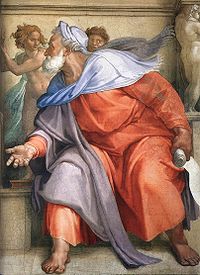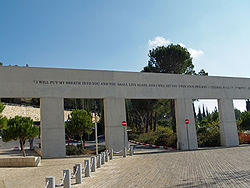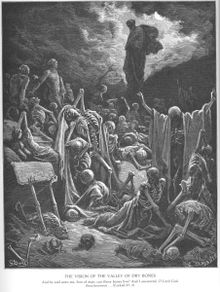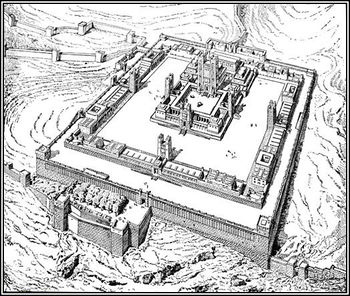Book of Ezekiel
The Book of Ezekiel is a book of the Hebrew Bible, and also recognized as divinely inspired (and therefore canonical) by most denominations of Christianity. The book derives its name from the prophet Ezekiel, a prophet from the sixth-century BC.[1] This book records Ezekiel's preaching. His name (Hb. Yekhezqe’l) means "God strengthens" or "May God strengthen". Ezekiel lived out his prophetic career among the community of exiled Judeans in Babylon. He belonged to the priestly class and was married (see Ezk. 24:15-24), but it is doubtful whether he had any children.
The frequent use of vivid, symbolic language causes this book to have much in common with the Book of Revelation in the New Testament.[2]
Contents |
Author
|
Part of a series
of articles on the |
|---|
| Tanakh (Books common to all Christian and Judaic canons) |
| Genesis · Exodus · Leviticus · Numbers · Deuteronomy · Joshua · Judges · Ruth · 1–2 Samuel · 1–2 Kings · 1–2 Chronicles · Ezra (Esdras) · Nehemiah · Esther · Job · Psalms · Proverbs · Ecclesiastes · Song of Songs · Isaiah · Jeremiah · Lamentations · Ezekiel · Daniel · Minor prophets |
| Deuterocanon |
| Tobit · Judith · 1 Maccabees · 2 Maccabees · Wisdom (of Solomon) · Sirach · Baruch · Letter of Jeremiah · Additions to Daniel · Additions to Esther |
| Greek and Slavonic Orthodox canon |
| 1 Esdras · 3 Maccabees · Prayer of Manasseh · Psalm 151 |
| Georgian Orthodox canon |
| 4 Maccabees · 2 Esdras |
| Ethiopian Orthodox "narrow" canon |
| Apocalypse of Ezra · Jubilees · Enoch · 1–3 Meqabyan · 4 Baruch |
| Syriac Peshitta |
| Psalms 152–155 · 2 Baruch · Letter of Baruch |
|
|
The Book of Ezekiel gives little detail about Ezekiel's life. He is mentioned only twice by name: Ezk. 1:3, where he writes that he was a priest, the son of Buzi; and Ezk. 24:24. He was one of the Israelite exiles, who settled in Tel-abib, on the banks of the Chebar, "in the land of the Chaldeans." He was most likely taken captive with King Jehoiachin (Ezk. 1:2; 2 Kings 24:14-16) about 597 BC.
The Jewish exiles repeatedly visited him to obtain a divine oracle (Ezk. 8, 14, and 20). However, Ezekiel exerted no permanent influence upon them, and repeatedly called them a "rebellious house" (see Ezk. 2:5-6, 8; 3:9, 26-27). If the enigmatical date, "the thirtieth year" (Ezk. 1:1), is understood to apply to the age of the prophet, then Ezekiel would have been born during the time of the spiritual reform of King Josiah.
Ezekiel lost his wife in the ninth year of his exile, A prophecy revealed in his own life through God (Ezk. 24:15-18 8:1; 24:18). The time and manner of his own death are unknown. Today his tomb is reputed to be located in the neighborhood of Hilla or ancient Babylon, at a place called Al Kifl.[3]
Date

Ezekiel's prophesies are more frequently dated than those of other Jewish prophets.[1] The first date of the book takes the reader to the summer of 593 BC, five years after the first group of exiles was deported to Babylon by Nebuchadnezzar. The latest-dated oracle comes 22 years after that summer, in April of 571 BC. It can be dated based on the links it records between the rule of King Jehoiachin (King of Jerusalem) and the other events that the book describes. According to this system, these prophecies were originally written in the 22 years between 593-571 BC.
The following table lists events in the Book of Ezekiel with their dates:
| Event | Verse Reference | Hebrew Date[4] | Gregorian Date (BC)[5] |
|---|---|---|---|
| Chariot Vision (Merkabah) | 1:1-3 | Tammuz 5, 3169 | June 15, 592 |
| Call to be a Watchman | 3:16 | Tammuz 12, 3169 | June 22, 592 |
| Temple Vision | 8:1 | Elul 5, 3170 | August 2, 591 |
| Discourse with Elders | 20:1 | Av 10, 3171 | July 26, 590 |
| Second Siege of Jerusalem | 24:1 | Tevet 10, 3173 | December 11, 589 |
| Judgment on Tyre | 26:1 | Nisan 1, 3175 | March 7, 586 |
| Judgment on Egypt | 29:1 | Adar II 12, 3174 | March 11, 587 |
| Judgment on Egypt | 29:17 | Nisan 1, 3191 | March 10, 570 |
| Judgment on Egypt | 30:20 | Nisan 7, 3175 | March 13, 586 |
| Judgment on Egypt | 31:1 | Sivan 1, 3175 | May 5, 586 |
| Lament over Pharaoh | 32:1 | Adar 1, 3176 | January 27, 585 |
| Lament over Egypt | 32:17 | Adar 15, 3176 | February 10, 585 |
| Fall of Jerusalem | 33:21 | Tevet 5, 3176 | December 3, 586 |
| New Temple Vision | 40:1 | Nisan 14, 3189 | March 16, 572 |
Content
- Inaugural vision (Ezekiel 1:1–3:27): The first chapter of the Book of Ezekiel begins with Ezekiel's record of his vision of God's spectacular chariot (see Merkabah).[6] In this vision, God approaches Ezekiel as a divine warrior, riding in his battle chariot. This chariot appeared to be drawn by four living creatures each having four faces (of a man, a lion, an ox, and an eagle), and four wings. These living creatures are traditionally known as the fixed signs of the astrology zodiac, namely Aquarius (the man), Leo (the lion), Taurus (the ox), and Scorpio (the eagle is the second symbol of the Scorpio sign). They could travel forward and backward, up and down, and they moved in flashes of lightning. Beside each "living creature" was a beryl-colored wheel, constructed as "a wheel within a wheel," with "tall and awesome" rims that were full of eyes all around. In this appearance of God unto Ezekiel here, he commissions him to be a prophet and a "watchman" in Israel: "Son of man, I am sending you to the Israelites." (2:3)
- Judgment on Jerusalem and Judah (Ezekiel 4:1–24:27): Ezekiel makes a series of denunciations against his fellow Judeans (3:22-24), warning them of the certain destruction of Jerusalem, in opposition to the words of the false prophets (4:1-3). The symbolic acts, by which the extremities to which Jerusalem would be reduced are described in Chapters 4 and 5, show his intimate acquaintance with the Levitical legislation. (See, for example, Exodus 22:30; Deuteronomy 14:21; Leviticus 5:2; 7:18,24; 17:15; 19:7; 22:8)
- Oracles against Foreign Nations (Ezekiel 25:1–32:32): Ezekiel announced that God would bring devastation to the nations that had troubled his people.[6] Against the Ammonites (Ezek. 25:1-7), the Moabites (25:8-11), the Edomites (25:12-14), the Philistines (25:15-17), Tyre and Sidon (26-28), and Egypt (29-32).
- After the Fall of Jerusalem (Ezekiel 33:1–39:29): This is after Nebuchadnezzar II destroys Jerusalem, when Ezekiel explained that the Jewish exile would come to an end. There would be the triumph of Israel.
- Vision of Restoration (Ezekiel 40:1–48:35): Ezekiel explained that the temple and Jerusalem would be gloriously restored and the people of God would be gathered and blessed as never before.[6] These would be Messianic times, and there would be the establishment and prosperity of the kingdom of God.
Historical background

The Book of Ezekiel was written for the captives of the tribe of Judah living in exile in Babylon following the Siege of Jerusalem of 597 BC. Up until that exile, their custom had been to worship their God in the Temple in Jerusalem. Exile raised important theological questions. How, the Judeans asked, could they worship their God when they were now in a distant land? Was their God still available to them? Ezekiel speaks to this problem. He first explains that the Judean exile is a punishment for disobedience and he then offers hope to the exiles, suggesting that the exile will be reversed once they return to God.
Unlike their ancestors, who were enslaved and socially marginalized while in exile in Egypt, the Jews of Ezekiel's time were able to become part of the society they found themselves in. The Exiles were told by Jeremiah not to worship the foreign gods, but Jeremiah did tell them that they could become part of the Babylonian culture. They did this well, often being called upon by the Babylonians to complete projects using their skills as artisans. Unlike other enemies, the Babylonians allowed the Jewish people to settle in small groups. While keeping their religious and national identities, many Jewish people did start to settle into their new environment. From building homes to opening businesses, the Jews seemed to settle into their exile land for the long haul.
This growing comfort in Babylon helps to explain why so many Jewish people decided not to return to their land. Many people would have been born in exile and would know nothing of their old land, so when the opportunity came for them to reclaim the land that was taken from them, many decided not to leave the Babylonian land they knew. This large group of people who decided to stay are known to be the oldest of the Jewish diaspora communities along with the Jews of Persia.
Ezekiel's resurrection of the dead

Ezekiel's greatest miracle consisted in his resurrection of the dead, which is recounted in Ezekiel 37. There are different traditions as to the fate of these men, both before and after their resurrection, and as to the time at which it happened.
Views of Jewish commentators
Jewish Bible commentators have been greatly divided on the interpretation of this section, and fall into two categories. One group believes that this event actually took place, while another group believes that Ezekiel was actually recording one of his prophetic visions.
In the former group, some rabbinic Jewish sources say that the resurrected men were godless people who had committed sins. Other rabbinic sources say that they were those Ephraimites who tried to escape from Egypt before Moses, and perished in the attempt. Some state that after Nebuchadnezzar had carried the youths of Judah to Babylon, he had them executed and their bodies mutilated, because their beauty had entranced the Babylonian women, and that it was these youths whom Ezekiel called back to life.
In the rabbinic midrash literature, it is written that the miracle was performed on the same day on which the three men were cast into the fiery furnace; namely, on Shabbat and Yom Kippur, (Cant. Rabbah vii. 9). Nebuchadnezzar, who had made a drinking-cup from the skull of a murdered Jew, was greatly astonished when, at the moment that the three men were cast into the furnace, the bodies of the dead boys moved, and, striking him in the face, cried out: "The companion of these three men revives the dead!" (see a Karaite distortion of this episode in Judah Hadasi's "Eshkol ha-Kofer," 45b, at foot; 134a, end of the section). When the boys awakened from death, they rose up and joined in a song of praise to God for the miracle vouchsafed to them; later, they went to the land of Israel, where they married and reared children.
As early as the second century, however, some authorities declared this resurrection of the dead was a prophetic vision: see the opinion regarded by Maimonides in his Guide for the Perplexed, II:46) This view has been adopted by his followers as the only rational explanation of the Biblical passage.
Vision of the Temple in Jerusalem

According to Walther Zimmerli, the number twenty-five is of cardinal importance in the Temple Vision of Ezekiel in chapters 40-48:
In the construction there appears the figure twenty-five and its multiples: the gate (inside measurement) is twenty-five cubits wide; its length (outside measurement) is fifty cubits; a hundred cubits is the distance from gate to gate; the inner court is a hundred cubits square; so that the total measurement of the temple area, as the measurement in 42:15-20 makes quite explicit, is five hundred square cubits. This system of measurement is still effective in the undoubtedly later description of the allocation of land in chapter 48 in the measurement of the terumah [consecrated area] in the narrower sense (48:20) at twenty-five thousand cubits by twenty-five thousand. But that is not all. The measurement of the steps of the ascent at the level of the sanctuary begins with the figure seven, which is again significance here (40:22, 26). The inner court is reached by eight steps (40:31, 34, 37), while the level of the temple building is reached by a further ten steps (40:49, emended text). Thus the measurement of the steps forming the ascent as a whole again comes to the figure twenty-five. From this point of view one cannot suppress the question whether the figure in the date in 40:1, the twenty-fifth year, is not also to be evaluated in this context of numerical stylization. [7]
Relation to the Old Testament
The Book of Ezekiel refers to the Torah quite often (e.g., Ezek. 27; 28:13; 31:8; 36:11, 34; 47:13, etc.), and shows on a number of occasions that its author is familiar with the writings of Hosea (Ezek. 37:22), Isaiah (Ezek. 8:12; 29:6), and especially with those of Jeremiah, (Jeremiah 24:7, 9; 48:37).
Ezekiel 14:14 and 14:20 mention a person by the name of "Daniel." Some see this as referring to the prophet Daniel, from the Book of Daniel. Ezekiel 28:3 also mentions this Daniel again as being preeminent in wisdom. In support of this interpretation it is noted that the name Daniel appears in the Book of Ezekiel immediately after the names of Noah and Job, two other major biblical characters. However, some disagree, noting that the Hebrew spelling Danel may refer to a different person.[8]
Relation to the New Testament
It is generally agreed that the closing visions of the Book of Ezekiel are referred to in the book of Revelation, in the Christian New Testament.
(Ezek. 38 = Rev. 20:8; Ezek. 47:1-8 = Rev. 22:1,2).
Other references to this book are also found in the New Testament. (Compare Epistle to the Romans 2:24 with Ezek. 36:22; Rom. 10:5, Galatians 3:12 with Ezek. 20:11; 2 Peter 3:4 with Ezek. 12:22.)
See also
| First Prophets |
|---|
| 1. Joshua |
| 2. Judges |
| 3. Samuel |
| 4. Kings |
| Later Prophets |
| 5. Isaiah |
| 6. Jeremiah |
| 7. Ezekiel |
| 8. 12 minor prophets |
- Apocryphon of Ezekiel
- Babylonian captivity
- Gog and Magog in Ezekiel
- Dhul-Kifl, The Islamic name of Ezekiel.
- List of names referring to El
Notes
- ↑ 1.0 1.1 ESV Study Bible, "Introduction to Ezekiel," (Crossway, 2007).
- ↑ Ronald F. Youngblood, F. F. Bruce, R. K. Harrison and Thomas Nelson Publishers, Nelson's New Illustrated Bible Dictionary, Rev. Ed. of: Nelson's Illustrated Bible Dictionary.; Includes Index. (Nashville: T. Nelson, 1995).
- ↑ "Dhu'l Kifl Shrine". http://archnet.org/library/sites/one-site.tcl?site_id=7827. Retrieved 2008-07-10.
- ↑ Hebrew dating is based on secular, not traditional dating. See Missing years for discussion of difference. Based on July 19, 586 Fall of Jerusalem, Ezekiel was apparently using accession year dating See Edwin_R._Thiele.
- ↑ http://www.abdicate.net/cal.aspx
- ↑ 6.0 6.1 6.2 Richard L. Pratt, ed. NIV Spirit of the Reformation Study Bible. Zondervan, 2003.
- ↑ Walther Zimmerli, Ezekiel 2,(Philadelphia: Fortress Press, 1983), p. 344].
- ↑ NIV footnote on Ezekiel 14:14
Further reading
Introductions to Ezekiel
- Jewish Encyclopedia: Book of Ezekiel
- Bible.org: Introduction to Ezekiel, based on Hill and Walton
- What Laws Were Not Good: A Canonical Approach to the Theological Problem of Ezekiel 20:25-26
On-line translations
- English Translation of the Greek Septuagint Bible: Ezekiel
- Yechezkiel from Chabad.org
- BibleGateway (Various translations)
| Preceded by Jeremiah |
Hebrew Bible | Followed by The Twelve Prophets |
| Preceded by Lamentations |
Protestant Old Testament | Succeeded by Daniel |
| Preceded by Baruch |
Roman Catholic Old Testament | |
| Preceded by Letter of Jeremiah |
Eastern Orthodox Old Testament |
|
||||||||||||||||||||||||||||||||||||
